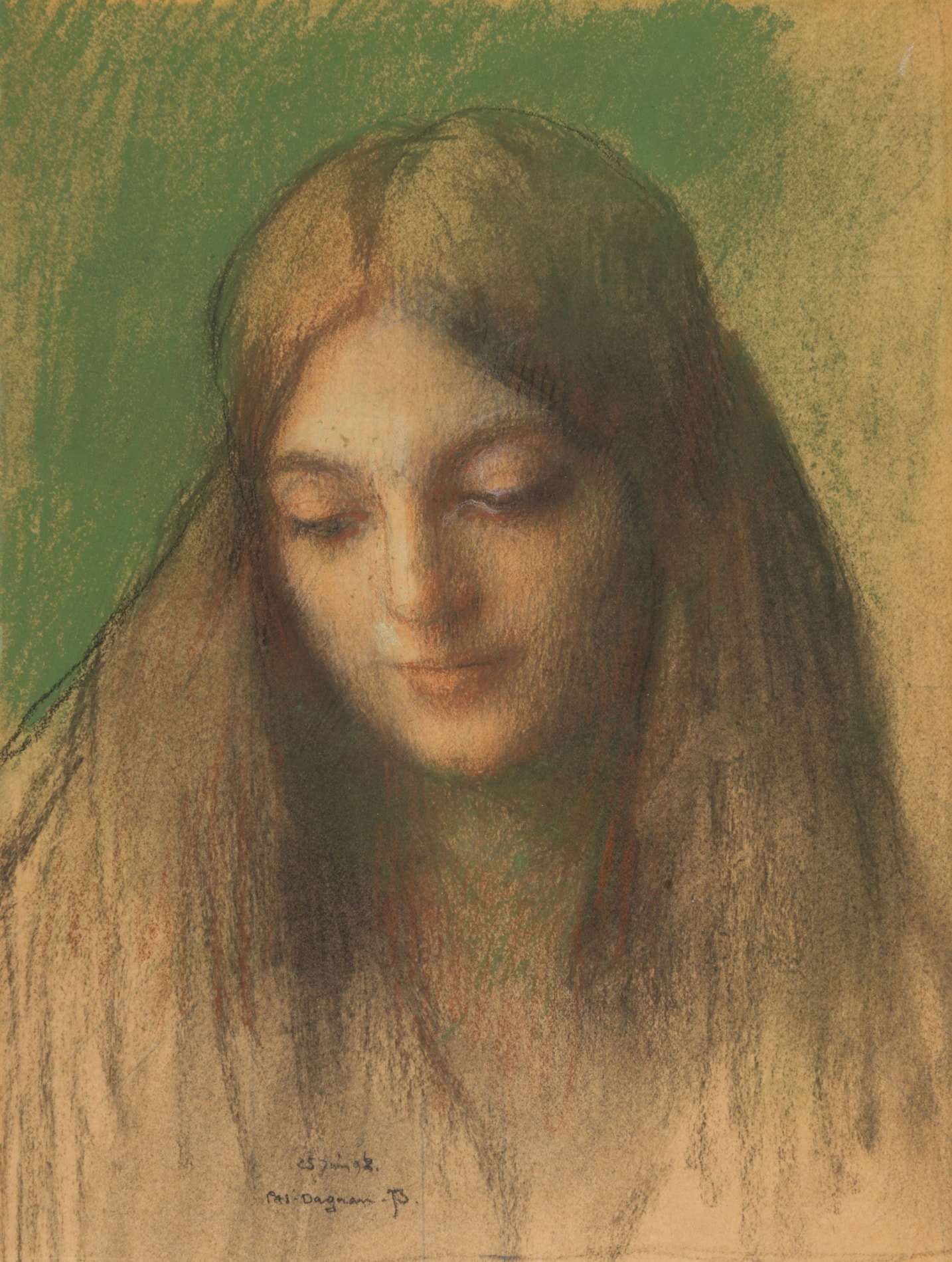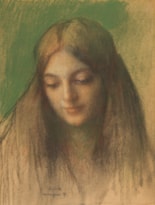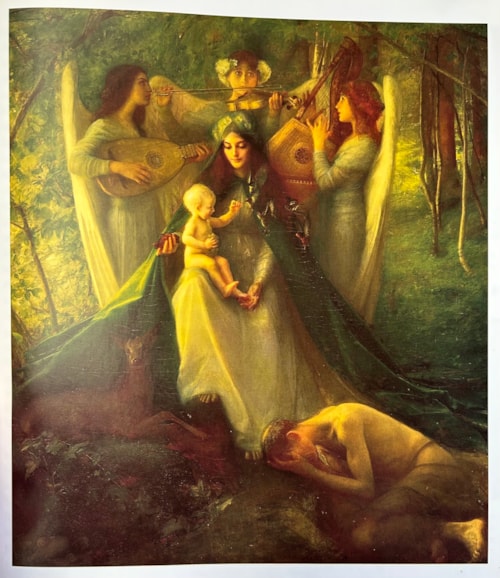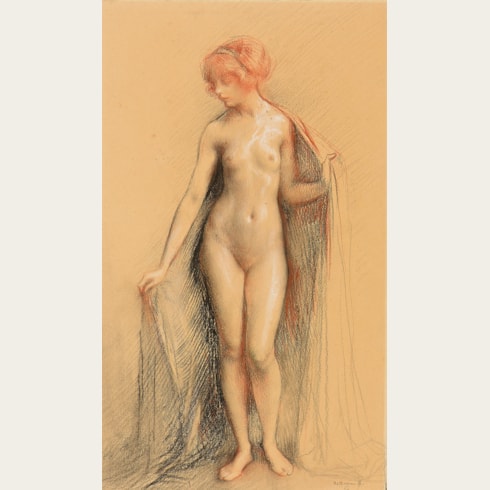Pascal-Adolphe DAGNAN-BOUVERET
(Paris 1852 - Quincey 1929)
The Head of the Virgin (Study for Consolatrix Afflictorum)
Pastel, heightened with touches of white, on buff paper laid down on card.
Signed and dated 25 juin 98. / Pas. Dagnan. B. at the lower right centre.
208 x 178 mm. (8 1/8 x 7 in.)
Signed and dated 25 juin 98. / Pas. Dagnan. B. at the lower right centre.
208 x 178 mm. (8 1/8 x 7 in.)
Dagnan-Bouveret worked painstakingly on each of his paintings, making numerous preparatory drawings for each composition. The present sheet is a study for the head of the Virgin in the artist’s major religious painting, Consolatrix Afflictorum, painted in 1899 and today in the collection of the Frick Art and Historical Center in Pittsburgh. The monumental painting, more than twelve feet high and nine feet wide, depicts the Virgin and Child seated in a wooded landscape and flanked by three music-making angels, while a cowering man, representing human suffering, is shown at the foot of the composition. Dagnan-Bouveret seems to have been thinking of the painting in December 1897, when he wrote to his wife that ‘I have a theme that would involve me, a type of Madonna of the Afflicted, which I think I have already discussed with you.’ The artist seems to have wanted to contrast the calmness of the pastoral setting and the innocent, gentle animals surrounding the Madonna and her attendant angels with the suffering man lying prostrate at her feet.
The American collector Henry Clay Frick had agreed to buy the painting of Consolatrix Afflictorum (Comforter of the Afflicted) for the sum of $22,000 from the art dealers Arthur Tooth & Sons in 1898, before Dagnan-Bouveret had even begun working on it. It was one of three large-scale paintings by Dagnan-Bouveret acquired between 1898 and 1901 by Frick, the others being Christ and the Disciples at Emmaus, painted in 1896-1897, and a commissioned portrait of his son Childs Frick, completed around 1899. Exhibited as part of a small retrospective exhibition of eight of Dagnan-Bouveret’s works at the Paris Exposition Universelle of 1900, for which the artist won the Grand Prix, Consolatrix Afflictorum was delivered the following year to Frick, who hung it in the dining room of his Pittsburgh estate, Clayton, where it remained after his eventual move to New York in 1914. A reproductive etching by Léopold Flameng after the painting of Consolatrix Afflictorum was published by Arthur Tooth & Sons around 1903.
A closely-related preparatory oil sketch on paper for the head of the Virgin in Consolatrix Afflictorum is in the collection of the Musée Georges-Garret in Vesoul. Other studies for the composition of the painting are known, including an early compositional sketch in pastel, gouache and ink in a private collection, and an oil sketch for the seated Christ Child, which is also in the Frick Art and Historical Center in Pittsburgh.
The American collector Henry Clay Frick had agreed to buy the painting of Consolatrix Afflictorum (Comforter of the Afflicted) for the sum of $22,000 from the art dealers Arthur Tooth & Sons in 1898, before Dagnan-Bouveret had even begun working on it. It was one of three large-scale paintings by Dagnan-Bouveret acquired between 1898 and 1901 by Frick, the others being Christ and the Disciples at Emmaus, painted in 1896-1897, and a commissioned portrait of his son Childs Frick, completed around 1899. Exhibited as part of a small retrospective exhibition of eight of Dagnan-Bouveret’s works at the Paris Exposition Universelle of 1900, for which the artist won the Grand Prix, Consolatrix Afflictorum was delivered the following year to Frick, who hung it in the dining room of his Pittsburgh estate, Clayton, where it remained after his eventual move to New York in 1914. A reproductive etching by Léopold Flameng after the painting of Consolatrix Afflictorum was published by Arthur Tooth & Sons around 1903.
A closely-related preparatory oil sketch on paper for the head of the Virgin in Consolatrix Afflictorum is in the collection of the Musée Georges-Garret in Vesoul. Other studies for the composition of the painting are known, including an early compositional sketch in pastel, gouache and ink in a private collection, and an oil sketch for the seated Christ Child, which is also in the Frick Art and Historical Center in Pittsburgh.
Pascal-Adolphe-Jean Dagnan-Bouveret entered the Ecole des Beaux-Arts in 1869, studying first with Alexandre Cabanel and then with Jean-Léon Gérôme. He first exhibited at the Salon in 1875, showing a painting -which was purchased by the State - and two drawings. He won second place in the Prix de Rome competition of 1876, but by 1878 had left the Ecole des Beaux-Arts. Following a visit to Franche-Comté later that year, Dagnan-Bouveret was inspired to paint subjects taken from rural life, and became a major exponent of naturalism in the later 19th century. He won medals at the Salons of 1878 and 1880, and his reputation was firmly established at the Salon of 1885, when a large painting of Horses at a Watering Place was acquired by the State. In the same year the artist was received into the Légion d’honneur, and made the first of several trips to Brittany, which was to be the inspiration for a number of important works of the later 1880s and early 1900s.
Among his most significant paintings of Breton subjects was The Pardon in Brittany, exhibited with much critical success at the Salon of 1878 and the Exposition Universelle of 1889 and today in the Metropolitan Museum of Art in New York. Dagnan-Bouveret also showed at the Salon de la Société Nationale from its inauguration in 1890 and, in the same year, at the Société des Pastellistes. From the 1890s onwards he began concentrating on portrait painting, for which he received several official commissions. Elected to the Institut de France in 1900, Dagnan-Bouveret received a grand prize at the Exposition Universelle the same year. In 1910 an album of facsimile reproductions of some of his portrait and figure drawings was published, with the title Choix de dessins de Dagnan-Bouveret. In 1930, a year after the artist’s death, a large retrospective exhibition of his oeuvre was held at the Ecole des Beaux-Arts, although by this time he was something of an anachronism, with his work long out of fashion.
Among his most significant paintings of Breton subjects was The Pardon in Brittany, exhibited with much critical success at the Salon of 1878 and the Exposition Universelle of 1889 and today in the Metropolitan Museum of Art in New York. Dagnan-Bouveret also showed at the Salon de la Société Nationale from its inauguration in 1890 and, in the same year, at the Société des Pastellistes. From the 1890s onwards he began concentrating on portrait painting, for which he received several official commissions. Elected to the Institut de France in 1900, Dagnan-Bouveret received a grand prize at the Exposition Universelle the same year. In 1910 an album of facsimile reproductions of some of his portrait and figure drawings was published, with the title Choix de dessins de Dagnan-Bouveret. In 1930, a year after the artist’s death, a large retrospective exhibition of his oeuvre was held at the Ecole des Beaux-Arts, although by this time he was something of an anachronism, with his work long out of fashion.
Provenance
Private collection, New York
Thence by family descent
Anonymous sale (‘Property of a Lady, New York’), New York, Sotheby’s, 31 January 2020, lot 424
Gallery 19C, Westlake, Texas
Private collection, North Carolina.
Thence by family descent
Anonymous sale (‘Property of a Lady, New York’), New York, Sotheby’s, 31 January 2020, lot 424
Gallery 19C, Westlake, Texas
Private collection, North Carolina.






